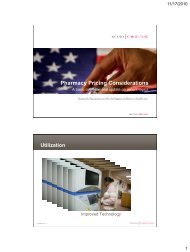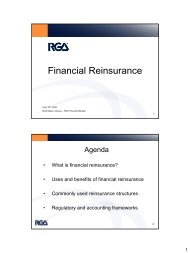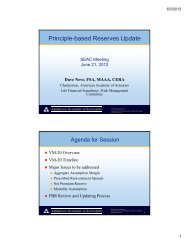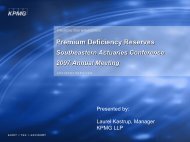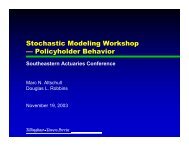The Effect of Medical Advances on Insurance ... - Actuary.com
The Effect of Medical Advances on Insurance ... - Actuary.com
The Effect of Medical Advances on Insurance ... - Actuary.com
You also want an ePaper? Increase the reach of your titles
YUMPU automatically turns print PDFs into web optimized ePapers that Google loves.
<str<strong>on</strong>g>Medical</str<strong>on</strong>g> Developments <str<strong>on</strong>g>of</str<strong>on</strong>g><br />
Underwriting Interest<br />
Mark Skillan, M.D.<br />
Munich American Reassurance Company<br />
Southeastern Actuaries Meeting<br />
June 21, 2007
• Developments <str<strong>on</strong>g>of</str<strong>on</strong>g> Interest in Infectious Disease<br />
• Genes, Mutati<strong>on</strong>s, Disease and Risk Assessment<br />
• Genetic Testing Regulatory Update<br />
• Stem Cell Update<br />
• Sec<strong>on</strong>d Cancers In Cancer Survivors
Infectious Diseases<br />
Tuberculosis<br />
Hepatitis<br />
Pandemic Flu
TB – Mycobacterium Tuberculosis<br />
• TB most <strong>com</strong>m<strong>on</strong> cause <str<strong>on</strong>g>of</str<strong>on</strong>g> infecti<strong>on</strong>-<br />
related mortality in world<br />
• > 2 Billi<strong>on</strong> infected (1 in 3)<br />
• 8-99 milli<strong>on</strong> develop active disease yearly<br />
• 2 milli<strong>on</strong> die yearly (1 in 8)
TB Death Rate<br />
• 7% industrialized west<br />
• 20% Central and South America<br />
• 35-40% parts <str<strong>on</strong>g>of</str<strong>on</strong>g> Asia and Africa<br />
• >50% parts <str<strong>on</strong>g>of</str<strong>on</strong>g> Africa (HIV)<br />
• Developing countries 95% cases, 98%<br />
deaths
TB Infecti<strong>on</strong> Cycle<br />
• Exposure to symptomatic infected pers<strong>on</strong><br />
• Infecti<strong>on</strong> (silent) –> > positive PPD skin test<br />
- usually not infectious<br />
- treatment goal - prevent disease<br />
• Symptomatic Disease -> > cough, weight loss,<br />
fever, etc. – infectious stage<br />
- treatment goal: cure disease<br />
- lack <str<strong>on</strong>g>of</str<strong>on</strong>g> treatment: illness, c<strong>on</strong>tagi<strong>on</strong>, death<br />
- inadequate treatment: illness, resistant<br />
TB forms arise, c<strong>on</strong>tagi<strong>on</strong>, death
MDR-TB<br />
• Multi-drug resistant form – first cases 1990’s<br />
• 2/3 cases in Russia, India, China<br />
• 500,000 cases in 2005<br />
• Resistant to first line drugs (INH, Rifampin)<br />
• Requires sec<strong>on</strong>d line drugs – at least 18 m<strong>on</strong>ths<br />
• Sec<strong>on</strong>d line drugs – less effective, more costly,<br />
less available
XDR-TB<br />
• Extensively Drug Resistant TB – 2005<br />
• Resistant to INH, Rifampin plus also<br />
flouroquinol<strong>on</strong>es, , and <strong>on</strong>e or more <str<strong>on</strong>g>of</str<strong>on</strong>g><br />
three injectable Rx’s<br />
• 2-10% TB cases today<br />
• Requires prol<strong>on</strong>ged RX with 2 nd and 3 rd<br />
line drugs<br />
• Out<strong>com</strong>e variable – cure currently possible
TB Remains a Treatable Disease<br />
• Objectives <str<strong>on</strong>g>of</str<strong>on</strong>g> <str<strong>on</strong>g>The</str<strong>on</strong>g>rapy<br />
Prevent or Cure Disease<br />
Curb Further Spread<br />
Prevent MDR and XDR-TB forms<br />
• Requires<br />
Early accurate Diagnosis<br />
Prompt curative therapy<br />
Patient <strong>com</strong>pliance with meds
Obstacles to Cure/Eradicati<strong>on</strong><br />
• Access to care - delayed diagnosis<br />
• Incorrect medicati<strong>on</strong> selecti<strong>on</strong><br />
• Inadequate durati<strong>on</strong> <str<strong>on</strong>g>of</str<strong>on</strong>g> therapy<br />
• Patient n<strong>on</strong>-<strong>com</strong>pliance<br />
• Cost/Availability Issues<br />
• HIV prevalence in some areas<br />
Results <str<strong>on</strong>g>of</str<strong>on</strong>g> Failure: uninterrupted cycle <str<strong>on</strong>g>of</str<strong>on</strong>g> infecti<strong>on</strong>,<br />
more MDR and XDR cases
TB:Bottom Line<br />
• Serious illness globally<br />
• MDR and XDR problem likely to grow<br />
• C<strong>on</strong>trollable in industrialized countries<br />
• New medical regimens and a vaccine are years<br />
away<br />
• Be aware <str<strong>on</strong>g>of</str<strong>on</strong>g> TB risk in internati<strong>on</strong>al business<br />
and in immigrants from high prevalence areas
Hepatitis A, B, C<br />
• 1 in 3 in the US have been infected by<br />
HAV, HBV or HCV<br />
• Impact for insurers (all lines) is significant<br />
and growing, especially for HCV
Hepatitis A (HAV)<br />
• Spread by fecal oral route<br />
• Mild to modest morbidity risk<br />
• No chr<strong>on</strong>ic HAV infecti<strong>on</strong> known<br />
• Limited/no mortality risk<br />
• HAV vaccine 1995 plus better public<br />
awareness -> > 84% decline in US cases
Hepatitis B (HBV)<br />
• Spread by blood products or intimate c<strong>on</strong>tact<br />
• Modest morbidity and small mortality risk with acute<br />
infecti<strong>on</strong><br />
• 5-10% develop chr<strong>on</strong>ic HBV infecti<strong>on</strong><br />
- 370 milli<strong>on</strong> worldwide have chr<strong>on</strong>ic HBV<br />
• Significant l<strong>on</strong>g-term morbidity and mortality risk for 5-5<br />
25% with chr<strong>on</strong>ic HBV<br />
- via cirrhosis, liver failure, liver cancer<br />
- durati<strong>on</strong> <str<strong>on</strong>g>of</str<strong>on</strong>g> chr<strong>on</strong>ic infecti<strong>on</strong> is key factor
Chr<strong>on</strong>ic HBV in U.S.<br />
• 60,000 new HBV infecti<strong>on</strong>s in US annually<br />
• 5-10% be<strong>com</strong>e chr<strong>on</strong>ic, but…<br />
• 1 milli<strong>on</strong> in US with chr<strong>on</strong>ic HBV
HBV C<strong>on</strong>trol Initiative in US<br />
• Blood supply screening for HBV<br />
• Universal precauti<strong>on</strong>s<br />
• HBV Vaccine (1984) prevents infecti<strong>on</strong><br />
- for at higher risk groups (HCW(<br />
HCW’s, , MSM, IVDU, etc)<br />
- universal childhood vaccinati<strong>on</strong> - new<br />
• <str<strong>on</strong>g>Effect</str<strong>on</strong>g>ive antiviral therapies to treat chr<strong>on</strong>ic HBV now<br />
available and in use (interfer<strong>on</strong>, ribavirin, , etc); cure rate<br />
~ 50%<br />
->> Dramatic decline in new cases (less chr<strong>on</strong>ic HBV)<br />
but…
HBV C<strong>on</strong>trol Challenge in U.S.<br />
• Chr<strong>on</strong>ic HBV now most <strong>com</strong>m<strong>on</strong>ly found in<br />
immigrant populati<strong>on</strong>s from high prevalence<br />
areas<br />
- Many infected since birth or childhood<br />
- Many unaware <str<strong>on</strong>g>of</str<strong>on</strong>g> chr<strong>on</strong>ic HBV status<br />
- L<strong>on</strong>g durati<strong>on</strong> <str<strong>on</strong>g>of</str<strong>on</strong>g> infecti<strong>on</strong> by middle age –<br />
at increased morbidity/mortality risk<br />
- 1,000,000 cases chr<strong>on</strong>ic HBV in U.S. now<br />
- 500,000 Asian/Pacific Islanders al<strong>on</strong>e
HBV Endemic Areas<br />
• Southeast Asia<br />
• Pacific Islands<br />
• Indian Subc<strong>on</strong>tinent<br />
• Japan<br />
• China<br />
• Middle East<br />
• Parts <str<strong>on</strong>g>of</str<strong>on</strong>g> Southern Europe and Africa
Bottom Line – Chr<strong>on</strong>ic HBV<br />
• US remains low prevalence country for chr<strong>on</strong>ic HBV<br />
• Vaccinati<strong>on</strong> plus effective therapies intended to reduce<br />
impact here<br />
• HBV testing for cause (elevated LFT’s) ) am<strong>on</strong>g PI’s s no<br />
l<strong>on</strong>ger <strong>com</strong>m<strong>on</strong>ly d<strong>on</strong>e – reas<strong>on</strong>able but…<br />
• Chr<strong>on</strong>ic HBV am<strong>on</strong>g immigrants from high prevalence<br />
areas should not be overlooked in risk assessment<br />
• Screening for HBV may remain a cost effective tool for<br />
pers<strong>on</strong>s born in high prevalence areas
Hepatitis C (HCV)<br />
• Formerly known as n<strong>on</strong>-A, n<strong>on</strong>-B B Hepatitis<br />
• Infecti<strong>on</strong> mostly via blood products<br />
- 240,000 cases per year in 80’s<br />
- Blood supply screening added since then<br />
- 26,000 cases per year now<br />
• 60-80% <str<strong>on</strong>g>of</str<strong>on</strong>g> those infected develop chr<strong>on</strong>ic HCV infecti<strong>on</strong>!<br />
• 5 Milli<strong>on</strong> in US with chr<strong>on</strong>ic HCV disease<br />
• Often silent
Impact <str<strong>on</strong>g>of</str<strong>on</strong>g> HCV<br />
• Minimal to mild morbidity with acute<br />
infecti<strong>on</strong>, minimal acute mortality<br />
• Significant l<strong>on</strong>g term morbidity mortality<br />
risk in 10-15% 15% with chr<strong>on</strong>ic HCV -<br />
- late effects: cirrhosis, liver failure, liver<br />
cancer<br />
- Chr<strong>on</strong>ic HCV -#1 cause for live<br />
transplantati<strong>on</strong> and hepatoma in US
HCV: Challenges Ahead<br />
• Large number <str<strong>on</strong>g>of</str<strong>on</strong>g> infecti<strong>on</strong>s in 1980’s s and before<br />
• Durati<strong>on</strong> <str<strong>on</strong>g>of</str<strong>on</strong>g> chr<strong>on</strong>ic infecti<strong>on</strong> key to HCV<br />
morbidity/mortality<br />
• An aging infected populati<strong>on</strong> now 20+ years out<br />
• Disease <strong>com</strong>plicati<strong>on</strong>s costs expected to peak by<br />
2015<br />
• Direct medical costs may reach $10.6 B USD<br />
during 2010-2019<br />
2019
Stopping HCV Progressi<strong>on</strong><br />
• Rate <str<strong>on</strong>g>of</str<strong>on</strong>g> liver fibrosis development can be slow, moderate<br />
or rapid<br />
• Limited ability to predict course at present:<br />
- following LFT’s – not reliable for HCV<br />
- serial liver biopsies: more definitive but<br />
unpopular (cost, risk, pain, error)<br />
- new FibroIndex (AST, platelet count, gammaglobulin<br />
level) – may lessen need for biopsy for some<br />
- determining viral genotype, following viral load are key<br />
-> > Treat those progressing and/or likely to resp<strong>on</strong>d to Rx
Predictors <str<strong>on</strong>g>of</str<strong>on</strong>g> Resp<strong>on</strong>se to <str<strong>on</strong>g>The</str<strong>on</strong>g>rapy<br />
Primary<br />
• Low viral load at<br />
outset<br />
• Genotype 2, 3, or 4 -<br />
80% SVR after 24wks<br />
(genotype 1 - 45%<br />
SVR after 48wks)<br />
Sec<strong>on</strong>dary<br />
• Age at time <str<strong>on</strong>g>of</str<strong>on</strong>g> Rx<br />
• Female<br />
• Caucasian<br />
• Normal BMI<br />
• Absent co-morbidities
Bottom Line: HCV<br />
• Chr<strong>on</strong>ic HCV an important disease in US<br />
• Is <str<strong>on</strong>g>of</str<strong>on</strong>g>ten silent<br />
• <str<strong>on</strong>g>Effect</str<strong>on</strong>g>ive screening is essential for insurers<br />
• Major wave <str<strong>on</strong>g>of</str<strong>on</strong>g> HCV- associated morbidity/mortality is<br />
building – prepare accordingly<br />
• <str<strong>on</strong>g>Effect</str<strong>on</strong>g>ive therapies exist and are key to morbidity and<br />
mortality reducti<strong>on</strong><br />
• <str<strong>on</strong>g>The</str<strong>on</strong>g>rapeutic advances in short term (STAT-C, new<br />
protease inhibitors) should improve Rx success rates but<br />
will not likely be a silver bullet
Pandemic Flu
Business C<strong>on</strong>tinuity Planning 2007
Requirements for Pandemic<br />
– A new influenza A virus must emerge<br />
• H5N1 is a new influenza A subtype<br />
– It must infect humans causing serious illness<br />
• As <str<strong>on</strong>g>of</str<strong>on</strong>g> 6/12/07, 312 people infected with H5N1, 61% have<br />
died<br />
– Efficient and sustained human to human<br />
transmissi<strong>on</strong><br />
• Not yet documented
Occurrence <str<strong>on</strong>g>of</str<strong>on</strong>g> Influenza Pandemics<br />
and Epidemics<br />
Disease incidence<br />
Pandemic<br />
Incidence <str<strong>on</strong>g>of</str<strong>on</strong>g> clinically manifest influenza<br />
Mean level <str<strong>on</strong>g>of</str<strong>on</strong>g> populati<strong>on</strong> antibody vs A HxNx<br />
Mean level <str<strong>on</strong>g>of</str<strong>on</strong>g> populati<strong>on</strong> antibody vs A HyNy<br />
Epidemic<br />
Interpandemic period<br />
Epidemic<br />
Epidemic<br />
Epidemic<br />
Pandemic<br />
1 2 3 4 5 6 7 8 9 10 11 12<br />
Time in years<br />
Epidemic<br />
Mean populati<strong>on</strong> antibody level<br />
Introducti<strong>on</strong> <str<strong>on</strong>g>of</str<strong>on</strong>g><br />
hypothetical<br />
A HxNx virus<br />
Significant minor variati<strong>on</strong> in A HxNx may<br />
occur at any <str<strong>on</strong>g>of</str<strong>on</strong>g> these points. Epidemics may<br />
or may not be associated with such variati<strong>on</strong>s<br />
Introducti<strong>on</strong> <str<strong>on</strong>g>of</str<strong>on</strong>g> hypothetical<br />
A HyNy (major new<br />
subtype), variant A HxNx<br />
disappears<br />
Mandell, Douglas and Bennett’s Principles and Practice <str<strong>on</strong>g>of</str<strong>on</strong>g> Infectious Diseases, 5 th ed. 2000:1829. Modified from<br />
Kilbourne ED. Influenza. 1987:274, with permissi<strong>on</strong>.
Infectious Disease Mortality in US 1900-2000<br />
Mortality Rate per 100,000<br />
1000<br />
800<br />
600<br />
400<br />
200<br />
0<br />
80<br />
60<br />
40<br />
20<br />
0<br />
1970 1980 1990<br />
1900 1920 1940 1960 1980<br />
Year<br />
Source: Armstr<strong>on</strong>g et al, JAMA, 1999; 281:61-66
Major Determinants <str<strong>on</strong>g>of</str<strong>on</strong>g> Mortality<br />
Rate in Pandemic<br />
• Lethality <str<strong>on</strong>g>of</str<strong>on</strong>g> Circulating Viral Strain<br />
• Ease <str<strong>on</strong>g>of</str<strong>on</strong>g> Transmissi<strong>on</strong><br />
• Size <str<strong>on</strong>g>of</str<strong>on</strong>g> Vulnerable Populati<strong>on</strong><br />
• Prevalence <str<strong>on</strong>g>of</str<strong>on</strong>g> Pre-morbid C<strong>on</strong>diti<strong>on</strong>s<br />
• Rapidity <str<strong>on</strong>g>of</str<strong>on</strong>g> Spread<br />
• Speed <str<strong>on</strong>g>of</str<strong>on</strong>g> Detecti<strong>on</strong><br />
• Accuracy <str<strong>on</strong>g>of</str<strong>on</strong>g> Diagnosis<br />
• Adequacy <str<strong>on</strong>g>of</str<strong>on</strong>g> Prophylaxis and/or Treatment<br />
• Accuracy <str<strong>on</strong>g>of</str<strong>on</strong>g> Death Certificates
Will <str<strong>on</strong>g>Effect</str<strong>on</strong>g>ive Human to Human<br />
Transmissi<strong>on</strong> <str<strong>on</strong>g>of</str<strong>on</strong>g> H5N1 Occur?<br />
Three scenarios possible:<br />
1. H5N1 remains in birds, other animals<br />
- fades in importance<br />
2. Jumps directly from birds to humans<br />
– Postulated to have occurred in 1918<br />
3. Combines with other influenza virus and then to<br />
humans<br />
– occurred in 1957 (Asian) and 1968 (H<strong>on</strong>g K<strong>on</strong>g)<br />
– Usually less virulent (partial immunity, etc.)
US Dept HHS Projecti<strong>on</strong>s<br />
Moderate (1957-like)<br />
Severe (1918-like)<br />
• 90 milli<strong>on</strong> ill (30%)<br />
• 45 milli<strong>on</strong> outPt care<br />
• 865,000 hosp care<br />
• 128,750 ICU care<br />
• 64,975 ventilator Pts<br />
• 209,000 Deaths<br />
• ? $18 Billi<strong>on</strong> health care<br />
cost<br />
• 90 milli<strong>on</strong> ill<br />
• 45 milli<strong>on</strong> outPt care<br />
• 9,900,000 hosp care<br />
• 1,485,000 ICU care<br />
• 742,500 ventilator Pts<br />
• 1,903,000 Deaths<br />
• $180 Billi<strong>on</strong> Health care<br />
cost
Health Care Capacity Issues<br />
• 700 fewer hospitals from 1993-2003<br />
- 200,000 fewer acute care beds<br />
- 425 fewer ER’s<br />
• Nursing shortages in many areas is routine<br />
• 50% <str<strong>on</strong>g>of</str<strong>on</strong>g> ER’s s already at or over capacity<br />
• 33% <str<strong>on</strong>g>of</str<strong>on</strong>g> Hospitals already losing m<strong>on</strong>ey<br />
• On-time Delivery System for Critical Supplies<br />
• Cost-cutting efficiencies limit “extra” equipment<br />
* Net <str<strong>on</strong>g>Effect</str<strong>on</strong>g> True Surge Capacity N<strong>on</strong>-Existent
WHO stages <str<strong>on</strong>g>of</str<strong>on</strong>g> pandemic alert<br />
Interpandemic phase<br />
New virus in animals,<br />
no cases in humans<br />
Pandemic alert<br />
New virus causes<br />
human cases<br />
Pandemic<br />
Low risk <str<strong>on</strong>g>of</str<strong>on</strong>g> human cases 1<br />
Higher risk <str<strong>on</strong>g>of</str<strong>on</strong>g> human cases 2<br />
No or very limited human-to<br />
to-<br />
human transmissi<strong>on</strong><br />
Evidence <str<strong>on</strong>g>of</str<strong>on</strong>g> human-to<br />
to-human<br />
transmissi<strong>on</strong><br />
Evidence <str<strong>on</strong>g>of</str<strong>on</strong>g> significant human-to<br />
to-<br />
human transmissi<strong>on</strong><br />
Efficient and sustained human-to<br />
to-<br />
human transmissi<strong>on</strong><br />
3<br />
4<br />
5<br />
6
Pandemic Business Scenarios<br />
Stage<br />
Business C<strong>on</strong>tinuity Issues<br />
Human Infecti<strong>on</strong><br />
Ec<strong>on</strong>omic <str<strong>on</strong>g>Effect</str<strong>on</strong>g><br />
3a<br />
• Public & employee “awareness” –<br />
current situati<strong>on</strong><br />
• No pers<strong>on</strong>-to-pers<strong>on</strong><br />
transmissi<strong>on</strong><br />
• No measurable impact<br />
3b<br />
4-5<br />
• Potentially distracting level <str<strong>on</strong>g>of</str<strong>on</strong>g><br />
anxiety am<strong>on</strong>g public and<br />
employees<br />
• Overseas travel restricti<strong>on</strong>s imposed<br />
by government<br />
• 24 hour media coverage, elevated<br />
c<strong>on</strong>cerns for pers<strong>on</strong>al/family safety<br />
• Increase in employee absenteeism<br />
• No pers<strong>on</strong>-to-pers<strong>on</strong><br />
transmissi<strong>on</strong><br />
• Pers<strong>on</strong>-to-pers<strong>on</strong><br />
transmissi<strong>on</strong> has occurred<br />
overseas<br />
• No measurable impact<br />
• Overseas supply chains<br />
interrupted<br />
• Some decline in equity markets<br />
6a<br />
• Regi<strong>on</strong>al travel restricti<strong>on</strong>s within U.S.<br />
imposed by government<br />
• Regi<strong>on</strong>al school & gov <str<strong>on</strong>g>of</str<strong>on</strong>g>fice closures<br />
• Pers<strong>on</strong>al/family safety primary c<strong>on</strong>cern<br />
• Sharp increase in employee<br />
absenteeism<br />
• Excess mortality rate based<br />
<strong>on</strong><br />
1957 & 1968 pandemic<br />
“moderate”<br />
• Significant but short-lived<br />
shock to equity markets<br />
• Short-lived world recessi<strong>on</strong><br />
6b<br />
• Widespread travel restricti<strong>on</strong>s within<br />
U.S. and around the world<br />
• School & gov <str<strong>on</strong>g>of</str<strong>on</strong>g>fice closures<br />
• Work be<strong>com</strong>es a low priority to most<br />
• Employee absenteeism is the norm<br />
• Excess mortality rate based<br />
<strong>on</strong><br />
1918 pandemic “severe”<br />
• Significant and lasting shock to<br />
equity markets<br />
• World recessi<strong>on</strong> for extended<br />
period
Pandemic Planning<br />
• Pandemics- not c<strong>on</strong>sidered preventable at this<br />
time – goal is to c<strong>on</strong>tain and reduce surge<br />
peak(s):<br />
- to effectively use resources available<br />
• SOA: Insurers should lead planning efforts -<br />
partner with government, <strong>com</strong>munities,<br />
hospitals, businesses and individuals in planning,<br />
risk management and recovery –<br />
- c<strong>on</strong>sider pro-activity an investment not an<br />
expense
Genetics, Mutati<strong>on</strong>s and Disease<br />
Genetic Testing Regulatory Outlook<br />
Status <str<strong>on</strong>g>of</str<strong>on</strong>g> Stem Cell Research
Genetic Testing<br />
• Hot topic in DC – S. 358 & HR. 493:<br />
President willing to sign a bill<br />
• Potential problems for risk assessment<br />
depending <strong>on</strong>:<br />
- definiti<strong>on</strong> <str<strong>on</strong>g>of</str<strong>on</strong>g> genetic test<br />
- lines to be covered<br />
- future legislative directi<strong>on</strong>s
Genetics<br />
• Study <str<strong>on</strong>g>of</str<strong>on</strong>g> genes, the biologic unit <str<strong>on</strong>g>of</str<strong>on</strong>g> heredity, -><br />
Learn structure and biochemical functi<strong>on</strong> -><br />
Potentials -><br />
- determine how body works normally and<br />
- what may c<strong>on</strong>tribute to or cause a disease<br />
- what may affect a disease’s s course<br />
- what may determine an individual’s s resp<strong>on</strong>se to<br />
therapy
Medicine <str<strong>on</strong>g>of</str<strong>on</strong>g> the Past
Medicine in the 21 st Century
Landmarks in Genetics History<br />
• 1859 Darwin - Origin <str<strong>on</strong>g>of</str<strong>on</strong>g> Species<br />
• 1865 Mendel – noti<strong>on</strong>/rules <str<strong>on</strong>g>of</str<strong>on</strong>g> inheritance<br />
• 1867 Meisch - DNA (nuclein(<br />
nuclein)<br />
• 1882 Meisch – chromosomes<br />
• 1908 Hardy-Weinberg<br />
Weinberg–populati<strong>on</strong> genetics<br />
• 1940’s s Pauling – c<strong>on</strong>cept <str<strong>on</strong>g>of</str<strong>on</strong>g> molecular disease<br />
• 1953 Wats<strong>on</strong> & Crick – model structure DNA<br />
• 1990 Human Genome project begins<br />
• 2005 Complete sequencing <str<strong>on</strong>g>of</str<strong>on</strong>g> human genome finished
Gene Functi<strong>on</strong>
Mutati<strong>on</strong>s: Basis for Disease<br />
• A change in DNA Code sequence in a gene<br />
al<strong>on</strong>g a chromosome<br />
• Can be silent, beneficial, deleterious<br />
• <str<strong>on</strong>g>Effect</str<strong>on</strong>g> depends <strong>on</strong> scale <str<strong>on</strong>g>of</str<strong>on</strong>g> change and<br />
area affected<br />
- Large scale versus small scale<br />
- Coding versus n<strong>on</strong> coding regi<strong>on</strong>
Size Of Mutati<strong>on</strong>
Causes <str<strong>on</strong>g>of</str<strong>on</strong>g> Mutati<strong>on</strong>s<br />
• Errors in DNA replicati<strong>on</strong> process (accident<br />
or chance)<br />
• Mutagen effect<br />
- UV, X-rays, X<br />
Radiati<strong>on</strong><br />
- chemicals that bind/react with DNA<br />
- chemicals whose metabolites generate<br />
reactive oxygen that damages DNA
How Mutati<strong>on</strong>s Arise
Beneficial Mutati<strong>on</strong>
Mutati<strong>on</strong> Repair<br />
• Is the norm<br />
• Complex biochemical repair mechanism<br />
exists<br />
• Routinely “pro<str<strong>on</strong>g>of</str<strong>on</strong>g> reads” the code, repairs<br />
as needed<br />
• Failure to repair -> > cellular dysfuncti<strong>on</strong><br />
medical illness, tumor, etc
Gene Studies<br />
• Detects mutati<strong>on</strong>s<br />
• Links mutati<strong>on</strong>s to disease manifestati<strong>on</strong>s<br />
• Provides potential point(s) ) <str<strong>on</strong>g>of</str<strong>on</strong>g> interventi<strong>on</strong> for<br />
targeted therapies:<br />
- gene repair (future)<br />
- supplement deficient gene product<br />
- counteract excessive gene product
Disease Cause C<strong>on</strong>tinuum
Single Gene Disorders<br />
• Follows Mendelian laws <str<strong>on</strong>g>of</str<strong>on</strong>g> inheritance<br />
- predictable disease incidence<br />
• Little envir<strong>on</strong>mental c<strong>on</strong>tributi<strong>on</strong><br />
• Well studied diseases, genetic tests available,<br />
few in number:<br />
- Hemophilia<br />
- Sickle Cell Disease<br />
- Huntingt<strong>on</strong>’s s Disease<br />
- Cystic Fibrosis…..
Comm<strong>on</strong> Complex Diseases<br />
• No clear Mendelian pattern <str<strong>on</strong>g>of</str<strong>on</strong>g> inheritance (not<br />
directly predictable)<br />
• Genetic and envir<strong>on</strong>mental c<strong>on</strong>tributi<strong>on</strong>s likely<br />
• Variable penetrance/expressi<strong>on</strong><br />
• Occurrence <str<strong>on</strong>g>of</str<strong>on</strong>g> protective and susceptibility genes<br />
• Familial aggregati<strong>on</strong>s may be seen<br />
• Includes most <str<strong>on</strong>g>of</str<strong>on</strong>g> the <strong>com</strong>m<strong>on</strong> diseases we<br />
underwrite:<br />
CVD, CA, Schizophrenia, DM, HCVD, AD,<br />
CVA, obesity,….
Familial Aggregati<strong>on</strong>
CVD - A Comm<strong>on</strong> Complex Disease
Recent Testing <str<strong>on</strong>g>Advances</str<strong>on</strong>g><br />
• Breast Cancer: MammaPrint – measures 70 gene<br />
markers in tumor – score predicts likelihood for<br />
recurrence in 10 years in Stage I or II node<br />
negative breast Ca<br />
• Leukemia: newly discovered 13 gene MicroRNA<br />
expressi<strong>on</strong> pr<str<strong>on</strong>g>of</str<strong>on</strong>g>ile (signature) in CLL indicates<br />
prognosis (time from diagnosis to need for<br />
treatment); may clue pathogenesis as well
Genetic Testing Regulatory<br />
Challenge: Percepti<strong>on</strong> vs. Reality<br />
• Except in rare single gene disorders, a genetic<br />
mutati<strong>on</strong> <str<strong>on</strong>g>of</str<strong>on</strong>g>ten does not = disease<br />
• Most <strong>com</strong>m<strong>on</strong> disorders are multi-factorial and<br />
<str<strong>on</strong>g>of</str<strong>on</strong>g>ten can be favorably influenced by early<br />
diagnosis, treatment and/or behavioral changes<br />
(CAD, DM, BRCA-1/2)<br />
• All <str<strong>on</strong>g>of</str<strong>on</strong>g> us likely have <strong>on</strong>e or more such mutati<strong>on</strong>s<br />
• Genetic testing not cost effective for insurers for<br />
single gene or <strong>com</strong>m<strong>on</strong> <strong>com</strong>plex disorders
Challenge: Should Private Insurers<br />
Have Access to <str<strong>on</strong>g>Medical</str<strong>on</strong>g> History?<br />
• Genetic discriminati<strong>on</strong> not documented to be a<br />
problem in private insurance market<br />
• ADA (1990) and HIPPA (1996) address primary<br />
c<strong>on</strong>cerns expressed plus<br />
• State laws already address employment issues<br />
(37 statutes) and health insurance issues (47<br />
statutes)<br />
• New legislati<strong>on</strong> risks – a broadened definiti<strong>on</strong> <str<strong>on</strong>g>of</str<strong>on</strong>g><br />
a genetic test, loss <str<strong>on</strong>g>of</str<strong>on</strong>g> access to full medical<br />
records, ? loss <str<strong>on</strong>g>of</str<strong>on</strong>g> family history, ? further<br />
micromanagement <str<strong>on</strong>g>of</str<strong>on</strong>g> risk assessment to follow
Stem Cells<br />
• Usual source is unused fertility clinic embryos<br />
• Pleuri-potent or omni-potent embry<strong>on</strong>ic cells<br />
• Further development <str<strong>on</strong>g>of</str<strong>on</strong>g> these cells depends <strong>on</strong><br />
envir<strong>on</strong>ment – horm<strong>on</strong>al, biochemical, etc.<br />
• <str<strong>on</strong>g>The</str<strong>on</strong>g>oretical potential to generate cells to use to<br />
repair or replace damaged or defective cells<br />
• Current efforts stymied by ban <strong>on</strong> federal<br />
funding <str<strong>on</strong>g>of</str<strong>on</strong>g> research <strong>on</strong> human embryos (Dickey-<br />
Wicker Amendment, 1996)
Stem Cells<br />
• Existing 20 stem cell lines old, problematic<br />
• Federal funding greatly missed<br />
• Privately funded and State funded<br />
research <strong>on</strong>going<br />
• Alternative ways to artificially produce<br />
stem cells also being studied
Sec<strong>on</strong>d Tumors in Cancer Survivors<br />
• In Same Organ or Different Organ/System<br />
Causes<br />
• Genetic susceptibility – <strong>com</strong>plex interplay<br />
• <str<strong>on</strong>g>The</str<strong>on</strong>g>rapy-related<br />
related – resp<strong>on</strong>se to chemo and/or<br />
radiati<strong>on</strong> exposure<br />
• Envir<strong>on</strong>ment<br />
• Behavioral factors – tobacco, alcohol, BMI,<br />
stress, activity…
Childhood Cancer Survivors<br />
• Survivors <str<strong>on</strong>g>of</str<strong>on</strong>g> certain cancers have lifetime RR <str<strong>on</strong>g>of</str<strong>on</strong>g> 10-20 for<br />
sec<strong>on</strong>d malignant neoplasm, e.g.,<br />
- MOPP- associated leukemia (ANLL)<br />
- radiati<strong>on</strong> treatment-associated associated cancer <str<strong>on</strong>g>of</str<strong>on</strong>g> breast<br />
(RR 14), thyroid, CNS, skin, sar<strong>com</strong>a<br />
-> > Other than recurrence <str<strong>on</strong>g>of</str<strong>on</strong>g> the primary tumor, a<br />
sec<strong>on</strong>d malignancy is <strong>com</strong>m<strong>on</strong>est cause <str<strong>on</strong>g>of</str<strong>on</strong>g><br />
death am<strong>on</strong>g l<strong>on</strong>g term childhood cancer<br />
survivors
Sec<strong>on</strong>d Malignancies in Adults after<br />
Hodgkin’s s Disease Treatment<br />
2nd Site<br />
Observed<br />
Expected<br />
RR<br />
All cancers 747 195 3.8<br />
Leukemia 116 5.2 22-95<br />
NHL 112 6.0 18.5<br />
Solid<br />
Tumors<br />
519 184 2.8-4.3
Sec<strong>on</strong>d Malignancies After<br />
Treatment for:<br />
• NHL – RR 1.2 to 1.8 by 10 yrs<br />
• Ovarian – RR 1.3 by 20 years<br />
• Testicular – RR 1.43<br />
• Risk varies: for some cancers the risk for 2 nd<br />
cancer peaks a few years after initial tumor<br />
treatment then declines, others - risk peaks at<br />
~10 years out then declines, still others - risk<br />
increases or remains stable over lifetime
Bottom Line- Sec<strong>on</strong>d Malignancies<br />
• Cancer treatment c<strong>on</strong>tinues to improve…<br />
• Growing populati<strong>on</strong> <str<strong>on</strong>g>of</str<strong>on</strong>g> survivors <str<strong>on</strong>g>of</str<strong>on</strong>g><br />
childhood and adult cancers -><br />
Growing populati<strong>on</strong> <str<strong>on</strong>g>of</str<strong>on</strong>g> pers<strong>on</strong>s at<br />
increased risk for a sec<strong>on</strong>d cancer<br />
• Out<strong>com</strong>e with sec<strong>on</strong>d cancer <str<strong>on</strong>g>of</str<strong>on</strong>g>ten<br />
less favorable – high morbidity/mortality<br />
• Limited data at this point for > 10-15 15 years<br />
• More recent/current regimens may be less toxic
Summary<br />
• TB a global issue; MDR and XDR worrisome<br />
developments<br />
• HBV significant world risk and in the US in immigrant<br />
from endemic lands<br />
• HCV-related morbidity and mortality <strong>on</strong> the rise<br />
• For HBV and HCV diagnosis and treatment are key to reducing<br />
morbidity and mortality risks<br />
• Genetic testing regulati<strong>on</strong> potentially pivotal for medical risk<br />
assessment in the US<br />
• Stem cell potential remains unrealized<br />
• Be aware <str<strong>on</strong>g>of</str<strong>on</strong>g> growing populati<strong>on</strong> <str<strong>on</strong>g>of</str<strong>on</strong>g> cancer survivors who may<br />
be at increased risk for a sec<strong>on</strong>d cancer and early mortality
Thank you
Key Resources<br />
www.pandemicflu.gov<br />
www.cdc.gov<br />
www.acli.<strong>com</strong>
Business & Pers<strong>on</strong>al Checklists<br />
‣Planning checklist<br />
‣ http://www.pandemicflu.gov/plan/checklists.html
Additi<strong>on</strong>al Pandemic Resources<br />
• Society <str<strong>on</strong>g>of</str<strong>on</strong>g> Actuaries: Potential Impact <str<strong>on</strong>g>of</str<strong>on</strong>g> Pandemic Influenza <strong>on</strong> the<br />
U.S. Life <strong>Insurance</strong> Industry, May 2007<br />
• U.S. Dept Homeland Security Preparedness and Recovery Guide:<br />
www.fsscc.org/reports/2006/CI_KR_Pandemic_Guide.pdf<br />
• Internati<strong>on</strong>al / World Health Organizati<strong>on</strong>: www.who.int/en<br />
• Europe: www.eurosurveillance.org/index-02asp<br />
• European Centre for Disease Preventi<strong>on</strong> and C<strong>on</strong>trol:<br />
www.ecdc.eu.int<br />
• American <str<strong>on</strong>g>Medical</str<strong>on</strong>g> Associati<strong>on</strong>: www.ama-assn.org<br />
assn.org<br />
• <strong>Insurance</strong> Informati<strong>on</strong> Institute: www.iii.org<br />
• Moody’s s Special Comment Bird Flu Risk for U.S. Life Insurers: a Tail<br />
event April 2007<br />
• Nati<strong>on</strong>al Associati<strong>on</strong> <str<strong>on</strong>g>of</str<strong>on</strong>g> Securities Dealers: Notice to Members 06-31





